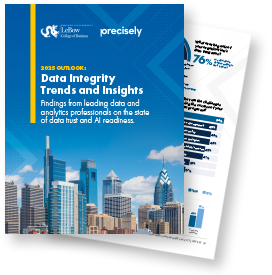Throughout my career I’ve traveled down two paths, and I’m passionate about both.
My first path centered on data strategy and management, teaching me that trusted data delivers great business outcomes. As a data management practitioner, I built and scaled data quality, master data management, and data governance solutions for a variety of organizations. I then transitioned into an industry analyst role with Forrester Research, helping other organizations on their data journeys.
My second path is as a marketing leader for solution providers (vendors delivering software and services). In my marketing roles, I’ve learned the value of storytelling and how to create value-driven, credible, and differentiated messages in the market. These stories drive awareness and interest in how my organizations could help customers and prospects solve their toughest data-centric challenges.
At face value, these appear to be two distinct careers: data management guy versus marketing guy. But that couldn’t be further from the truth.
The value of trusted data-driven decision-making to support marketing is clear to most marketers, so I’m not going to discuss that here.
Instead, I’m going to speak directly to data and AI strategy leaders – all of you Chief Data Officers (CDOs), Chief Data & Analytic Officers (CDAOs), heads of data strategy, data governance, data management, AI and Data. Here’s my message:
Data leaders: It’s time to understand that the key to your data strategy success is how effectively you market it.

Uncanny Similarities Between Data and Marketing Strategies
I recently attended the Gartner Data & Analytics Summit in Orlando and was equally excited and concerned about the state of data, based on my conversations with attendees and the insights shared by Gartner’s expert analysts.
On the positive side, Gartner analysts consistently emphasized that data integrity remains a critical path to the success of almost every strategic initiative under the sun, be it AI-readiness, digital transformation and modernization, customer experience, regulatory compliance, and many others.
But unfortunately, in many of the sessions I attended, analysts also shared that while data leaders like CDAOs were effective in the execution of data projects, they struggled with key strategic foundations, like aligning with business value, business buy-in, data literacy, and data governance. (You can check out my post-event summary here).
2025 Outlook: Essential Data Integrity Insights
What’s trending in trusted data and AI readiness for 2025? The results are in!

In Gartner VP Analyst Saul Judah’s presentation, “How to Create a Data and Analytics Strategy for Real Business Results,” Saul gave advice to data leaders on how to create a compelling vision, and the four questions their strategy must answer.
These questions were impactful to me, because they’re identical to those that marketers must ask when defining a go-to-market strategy for any solution:
- “Who are my stakeholders, both internal and external?” In marketing-speak, this is called your “Ideal Customer Profile” or ICP. You need to define the roles & responsibilities, job titles, market segments, industries, and so forth that are most likely to prioritize your solution. In the data world, your stakeholders may be internal business functions looking to improve their operations or decision-making, or it could be creating better experiences for your customers, suppliers, or other external constituents.
- “What are their goals, in business and in life?” Once you know your ICP, you need to understand what makes them tick: What parts of their role keep them up at night? What are their career aspirations? What are their most common challenges? Helping individuals be personally successful ensures their support and evangelism – equally important for selling software or getting buy-in for a data initiative.
- “What initiatives generate the most business outcome value, contributing to those stakeholder goals?” In both marketing and data strategy, we’re looking for the top priority use cases and budgeted programs that will deliver the measurable results that the business requires – be it revenue growth, operational efficiencies, customer retention, risk reduction, or similar strategic goals. The greater the value delivered, the better the chance you’ll have the support to keep going.
- “How will we measure the results?” All marketing investments, whether in brand, events, digital campaigns – you name it – must be measured to prove there is a return on those investments. Data programs are no different.
Mapping Data and Marketing Efforts
Need more proof that data strategy evangelism is just marketing leadership in disguise? Take a look at the table below. I’ve listed some of the most critical marketing activities and share how they translate to ensuring an effective data strategy:
|
Activity |
Marketing Purpose |
Data Strategy Purpose |
| Market research | Identify customer trends and priorities. Understand which initiatives are being prioritized and budgeted to help identify the best messages and campaigns to drive qualified leads. | Identify best practices, technology trends, and other techniques by networking and engaging with peer organizations, consultants, vendors, industry analysts, and others. |
| Competitive intelligence | Understand the alternatives your ICP considers when trying to solve the problem your solution addresses. | Understand how your competitors use data to their advantage – to create better customer experiences, improve operational efficiencies, and gain market share from you. |
| Value-based positioning | Articulate the positive business impact an investment in your solution delivers to your customers. | Articulate the positive business impact that prioritizing your data strategy can deliver to your organization. |
| Brand perception and market education | Make sure your target market knows who you are, what value you deliver, and why you’re uniquely positioned to solve their problem better than any alternative. | Make sure your entire organization understands why your data strategy is so critical to success – highlight the role of trusted data in your most strategic initiatives. |
| Persona-marketing | Make solutions relevant to unique roles in a sales cycle (end user vs. budget-holder vs. influencer vs. decision-maker vs. project leader). | Make your data strategy relevant to unique roles and functions within your organization (marketing vs. finance vs. sales vs. IT; leadership vs. analysts vs. customer-facing reps, etc.) |
| Differentiation | Highlight what makes your solution so valuable by identifying the most distinctive, credible, easily provable, and advantageous aspects of your business. | Highlight what makes your data strategy’s proposed changes and innovations so much more valuable than sticking with the status quo. |
| Customer advocacy | Our customers are our most valuable evangelists. If they’re willing to share that our solution was valuable for them, our prospects will be more willing to work with us. | The internal departments and individuals within our organization that were the early adopters, proving the value of our data strategy to their roles, will be our most powerful evangelists. They’ll help to spread adoption across the rest of the organization. |
| Content marketing | We need a pitch deck, a website, webinars, white papers, case studies, data sheets, demos, and more to educate and explain the value of our solution to the market. | We need a business case, brown-bag lunch roadshow deck, an Intranet site, demos, and other documentation to educate and energize the organization about our data strategy. |
| Demand generation (events, webinars, emails, comms) | Marketing demand generation activities have two key roles: market awareness and pipeline creation. Marketing drives thought leadership, compelling content, social, email, digital, events, and other types of campaigns to get the word out about your great solutions and drive interest. | Your data strategy also requires a pipeline of potential customers – but those customers will be your cross-functional colleagues. Especially in large enterprises, you need to get the word out that there are programs underway that could significantly benefit their specific parts of the business. Use internal channels such as all-hands meetings, employee newsletters, Slack or Teams, email, Intranet, and lunch & learn meetings to reach as many supporters as possible. |
| Marketing Operations & Reporting | A clear ROI (return on investments) and other key performance indicators (KPIs) for whatever solution you’re selling is critical. First, it helps your prospects build an effective business case to secure budget for your solution. And equally critical, it helps to prove post-purchase business value to support renewals and growth of the account. | How your data strategy investments support organizational goals and KPIs are equally important. You need to justify investment in data people, process, and technology – and you need to prove that business value is being delivered to receive continued executive sponsorship and resources. |
| Rinse and repeat | The “Rule of 7” is a popular marketing principle that says a potential customer must encounter a brand’s marketing messages at least seven times before making a purchase decision. So, “one and done” doesn’t work. | A one-off presentation at an employee all-hands meeting isn’t enough. Data leaders must consistently reinforce and update the organization on the data strategy’s progress and results to ensure ongoing excitement and support. |
So, Should Your CMO Be the New CDO?
No, of course not.
The CDO, CDAO, and related data strategy leadership roles require a breadth and depth of data management experiences that are truly unique and critical to the success of strategic data initiatives.
But these data leaders should absolutely consider hiring team members that can bring some of these marketing skills to their organizations, and work closely with their marketing colleagues for support and advice.
The bottom line is this: if you want your initiatives to gain traction, don’t just think like a data leader – think like a marketer.







